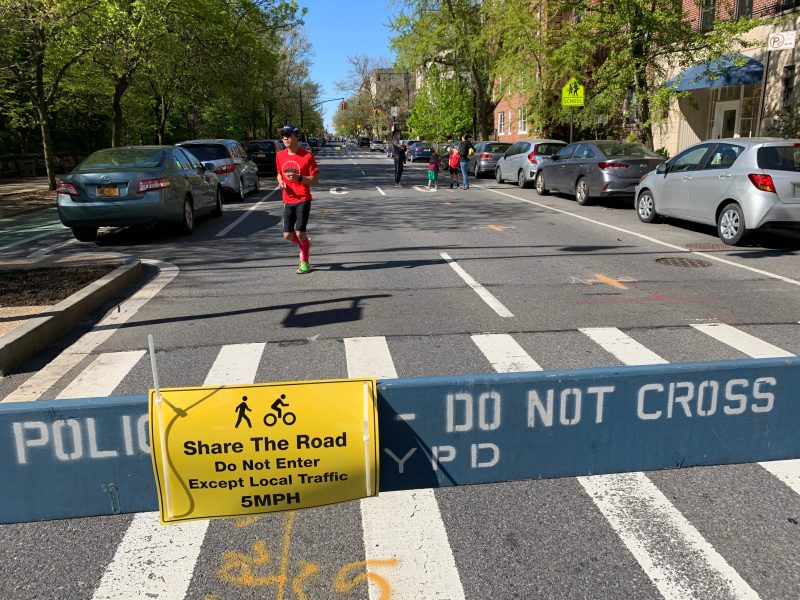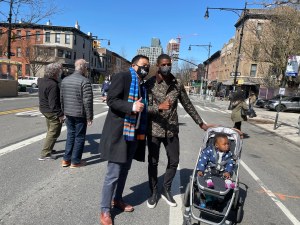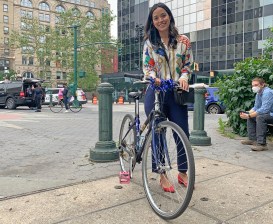Mayor’s ‘Open Streets’ Are In Wealthier Neighborhoods, Data Show

Whose streets? The wealthy’s.
Mayor de Blasio’s Open Streets program — meant to give New Yorkers socially distanced recreation space during the COVID-19 crisis — caters to the rich, a Streetsblog analysis shows.
The city’s median household income is $60,762, but on streets that are part of the program, the median income average is $81,567, according to Census data for the city’s 235 open street locations analyzed by Streetsblog. And the same pattern emerges in the three most-populous boroughs:
- In Brooklyn, where the median household income is $56,446, the median income average of the city’s open streets is $88,294 — roughly $32,000, or nearly 50 percent, more.
- In Queens, where the median income is $65,534, the median income average of the open streets is $70,355, or 10 percent more (and nearly 20 percent more than the city median).
- In Manhattan, where the median income is $83,151, the median income average of the open streets is $97,733 — $14,582, or 17 percent, more than the borough median (and 60 percent above the city median).
In the Bronx and Staten Island, the pattern does not hold. In both cases, the areas with open streets are poorer than the borough average — by 10 percent in The Bronx and 39 percent in the least-populous borough.
The current collection of 70-plus miles of open streets are more equitably distributed than they were earlier in the program, but activists said it’s no surprise that they are still in wealthier neighborhoods overall because that’s how improvements seem to begin in this city.
“Historically, the city has distributed street safety projects and it’s never been in an equitable way,” Erwin Figueroa, an organizer with Transportation Alternatives.
Indeed, three months into the program, there are no open streets in Bay Ridge, Bensonhurst, Coney Island, Flatlands, East Flatbush or Canarsie in Brooklyn; Wakefield and other open-space-deprived areas of The Bronx; or in COVID-19 hotspots like Elmhurst or Corona, according to the ever-updated map on the Department of Transportation website.
Coney Island Council Member Mark Treyger said he would support open streets in his district, but did not receive any requests from the local community board, or anyone else.
The city has admitted that it has the burden in such cases. On opening day of the program back in May, DOT Commissioner Polly Trottenberg was asked about the gap between the haves and have-nots and said she was committed to leveling the play street field.
“We hope in the coming weeks to roll out a bunch of different places,” she said when the program consisted of just a few miles of streets. “Neighborhoods, though, where we think we really need to do this, but maybe there isn’t a local partner, those may be places where you will see more city staff stepping in to make sure it will happen.”
In the first iteration of the program back in April, “city staffing” meant deploying so many cops that the program could only fail. Even though police no longer enforce the roadways (though many precincts still set up barricades every day), the stigma of over-policing remains.
East New York Council Member Inez Barron told Streetsblog that at first her office did not want any open streets since the city initially said they would be manned by cops — who disproportionately target and harass Black and brown people — but now is working with her colleagues and DOT to come up with a list that would benefit the community.
“They’re no longer involved in patrolling, so … we decided in conjunction with the community board that this us something viable and would have positive benefits,” said Barron.

The Streetsblog analysis of median income comes after the Trust for Public Land had cross-referenced the city’s program with sections of town with the greatest need for open space.
“If one of the goals is to alleviate park need, the city needs to do more,” said Carter Strickland, the group’s New York director.
The group’s updated map still shows many areas of the city where residents are more than a 10-minute walk from greenspace, yet still don’t have any open street for socially responsible recreation.
A spokesman for City Hall said the open streets program is the “biggest in the country,” with streets in all five boroughs and “across a range of median incomes.” In the last tranche of openings last month, the city added more blocks in low-income communities of color such as Brownsville, Harlem, Morrisania, and East New York, where there were none before.
“We’ve made enormous progress toward delivering on that goal. There’s more work to do, and we’re not done adding streets yet – but we’re proud of this program and look forward to expanding it,” said the spokesman, Mitch Schwartz.
Some problems surrounding the program stem from how it was set up. City officials said from the beginning that local NYPD precincts could handle most of the set-up and breakdown of barricades every day — but many areas would need community groups or business improvement districts to take the lead.
3) The program is structurally racist, at best.
This is the point that screamed out at me as I made my ride today. I don't know how else to say it: Open Streets in Brooklyn are effectively only open if white people live on them. I know that sounds harsh, but the data are stark.
— Sasha Aickin (@xander76) July 6, 2020
Open streets that are supposed to be set up by the police have been inconsistent, with barricades frequently misplaced or missing. On Avenue B in Manhattan and on several streets in Greenpoint, locals simply took over from the cops because the NYPD was doing such a poor job.
On any given day, the cops could simply fail to put out the barricades. A one-day snapshot of 44 of the 79 open streets in Brooklyn written up earlier this month revealed how common that problem is.
“Open Streets” in Harlem pic.twitter.com/qfP1B0OLRM
— Erin Durkin (@erinmdurkin) July 17, 2020
Some community groups have risen to the challenge. But other neighborhoods still aren’t in the program. Sometimes, that’s simply due to bad leadership by the local council member. Indeed, in the Bronx, Council Member Mark Gjonaj demanded — and got — the removal of the open street in his district. Other council members simply haven’t demanded open streets from City Hall.
The income disparity among open streets that are also part of the mayor’s “open restaurant” plan is even greater than with the larger open streets plan. On the 48 open streets that are closed to cars for al fresco dining from Friday night through Sunday night, the median household income is $106,108 — $45,000 more than the citywide median, and still $24,000 more than the average of the overall open streets program.
Transportation Alternatives released its own report Wednesday highlighting the failures of the open streets program, saying that it “lacks vision and ambition” because it was rolled out in an inequitable way that benefits wealthier New Yorkers already rich with open space, rather than those who need it most.
In addition to Streetsblog’s findings that the open streets are disproportionately in high-income areas, Transportation Alternatives also found that only 37 percent of New Yorkers live within walking distance of an open street, and only 20.5 percent of New Yorkers who live within walking distance of an open street are Black, the group said.
Methodology
To calculate the numbers in this story, Streetsblog used median household income statistics from the Population Factfinder on the website of the Department of City Planning, which is based on Census data. Most of the open streets fall within a single Census tract. On streets that cut across multiple Census tracts, Streetsblog took the median household income for all of the tracts through which the open street passes.
With Adam Light and Steven Vago





